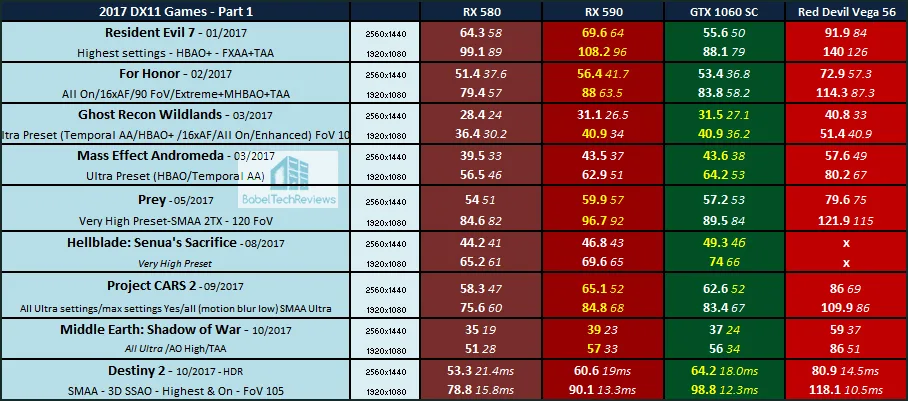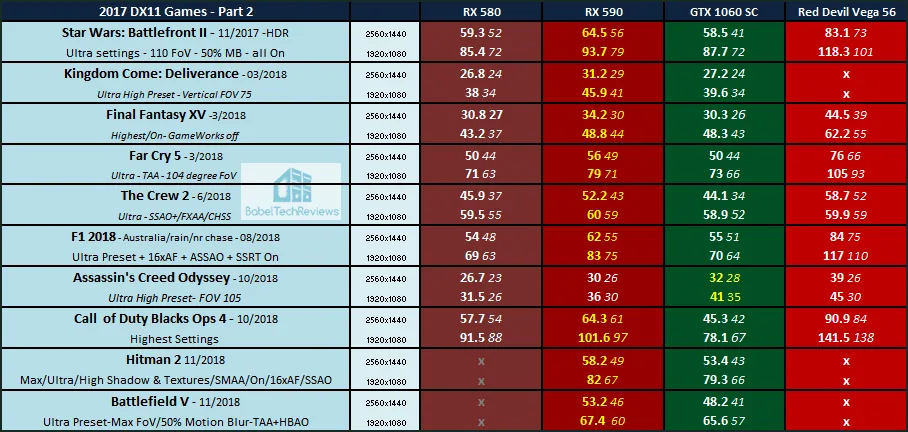The PowerColor Red Devil RX 590 8GB takes on the EVGA GTX 1060 SC 6GB in 37 Games
The RX 590 arrived at BTR for evaluation as an 8GB Red Devil video card from PowerColor priced at $279.99. We have been benching it versus the Gigabyte RX 480 G1 8GB at RX 580 clocks, and versus the $259 EVGA GTX 1060 SC 6GB video card using 37 games and 2 synthetic benchmarks. Although the Red Devil RX 590 is a refresh of the Red Devil RX 580 with the same 2000MHz memory clocks, it is now on the 12nm process which has allowed Polaris to really flex its muscle with a substantial overclock to its core.
 This brand new card has been released today at the PowerColor Red Devil factory overclocked speed of 1576MHz. By comparison, AMD’s reference RX 590 which is also priced at $279 has a base clock of 1469MHz and a boost clock of 1545MHz which still faster than any factory overclocked RX 580 such as the Sapphire Nitro Pulse which clocks to 1430MHz and also sells for $279 .
This brand new card has been released today at the PowerColor Red Devil factory overclocked speed of 1576MHz. By comparison, AMD’s reference RX 590 which is also priced at $279 has a base clock of 1469MHz and a boost clock of 1545MHz which still faster than any factory overclocked RX 580 such as the Sapphire Nitro Pulse which clocks to 1430MHz and also sells for $279 .
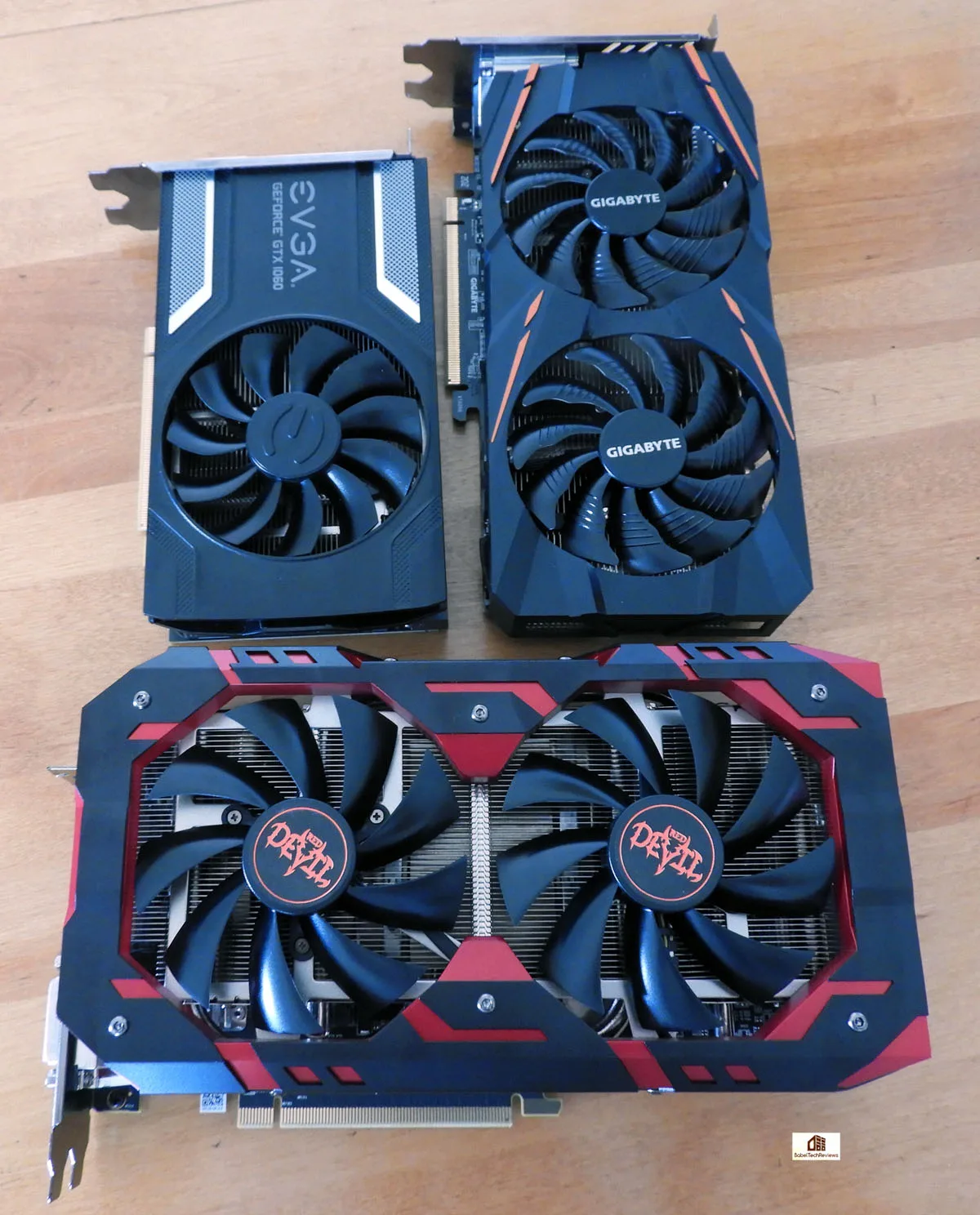
Besides benching the Powercolor RX 590 versus a RX 480 at stock RX 580 clocks (1340MHz), we will also benchmark the only other other competing NVIDIA card in a similar price range – the EVGA GTX 1060 6GB SC (“superclocked” edition) – to see where the new Red Devil RX 590 stands regarding price versus performance. In addition, we shall show the performance of the PowerColor Red Devil RX Vega 56 which is in a much higher price range and higher class.
AMD released its Polaris architecture as the RX 480 on June 29, 2016. We followed its progress with improved drivers, and we also saw that it was only a fair overclocker versus the GTX 1060 SC. The RX 580 released afterward as identical to the RX 480 but with higher core clocks, and our Gigabyte RX 480 8 GB G1 Gaming was able to match its 1340MHz reference core clock with a simple overclock. This same card will stand in today for a stock RX 580.
Let’s take a look at the specifications of the PowerColor Red Devil RX 590.
The Red Devil RX 590 8GB Features & Specifications
Here are the specifications for the $279 PowerColor Red Devil RX 590 which comes with a code for a three-game bundle worth up to $180 – Resident Evil 2, Devil May Cry 5, and The Division 2.
The major upgrade to the specifications of the PowerColor Red Devil RX 590 over the RX 580 is an increase of 236MHz to the Boost clock from the RX 580’s 1340MHz by virtue of being fabricated on the 12nm process. In addition, the Red Devil RX 590 has two BIOSes easily accessed by a switch. The Silent BIOS allows for very quiet operation and power efficiency while the Performance BIOS is for gaming with no power limit overclocking.
The RX 590 Red Devil Performance mode uses a temperature target set at about 70C while the Silent mode uses a target of 80C to allow the fan profile to reach quiet operation while still allowing for some overclocking.
Designed for further manual overclocking, the Red Devil RX 590 has improved the VRMs over the RX400 series with enhanced 6+1 power phases using DrMos, their highest rated Digital power. It also uses 8×6 power pin connectors.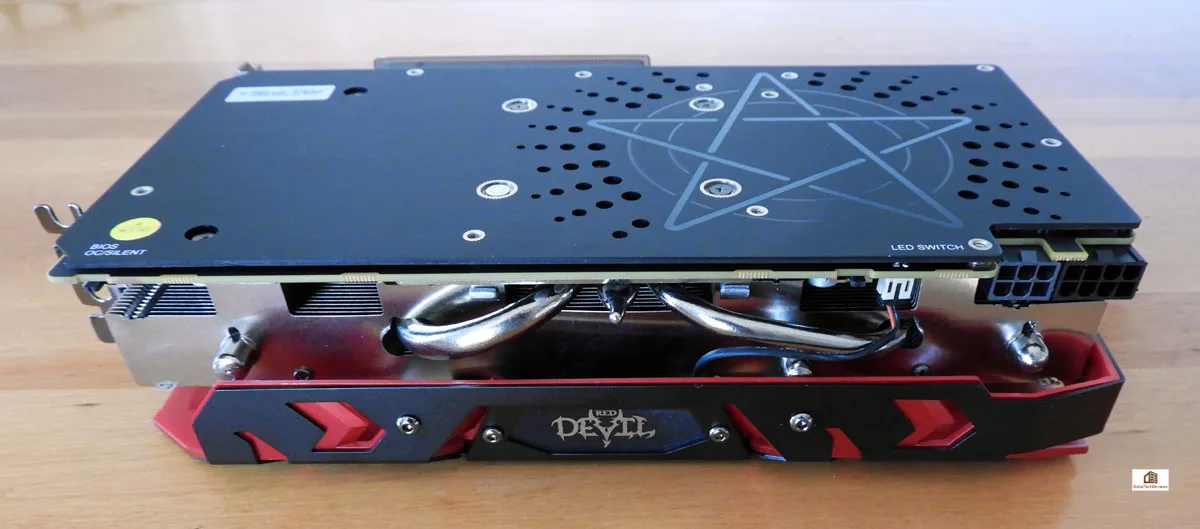 PowerColor uses spring screws to pin through the rivets of the blackplate and the PCB to lock in the thermal module so the overall structure remains super solid.
PowerColor uses spring screws to pin through the rivets of the blackplate and the PCB to lock in the thermal module so the overall structure remains super solid.
Our Test Bed
We shall test 37 games and 2 synthetic benchmarks at 1920×1080 and at 2560×1440. We have just added Battlefield V and Hitman 2 which both released this week. 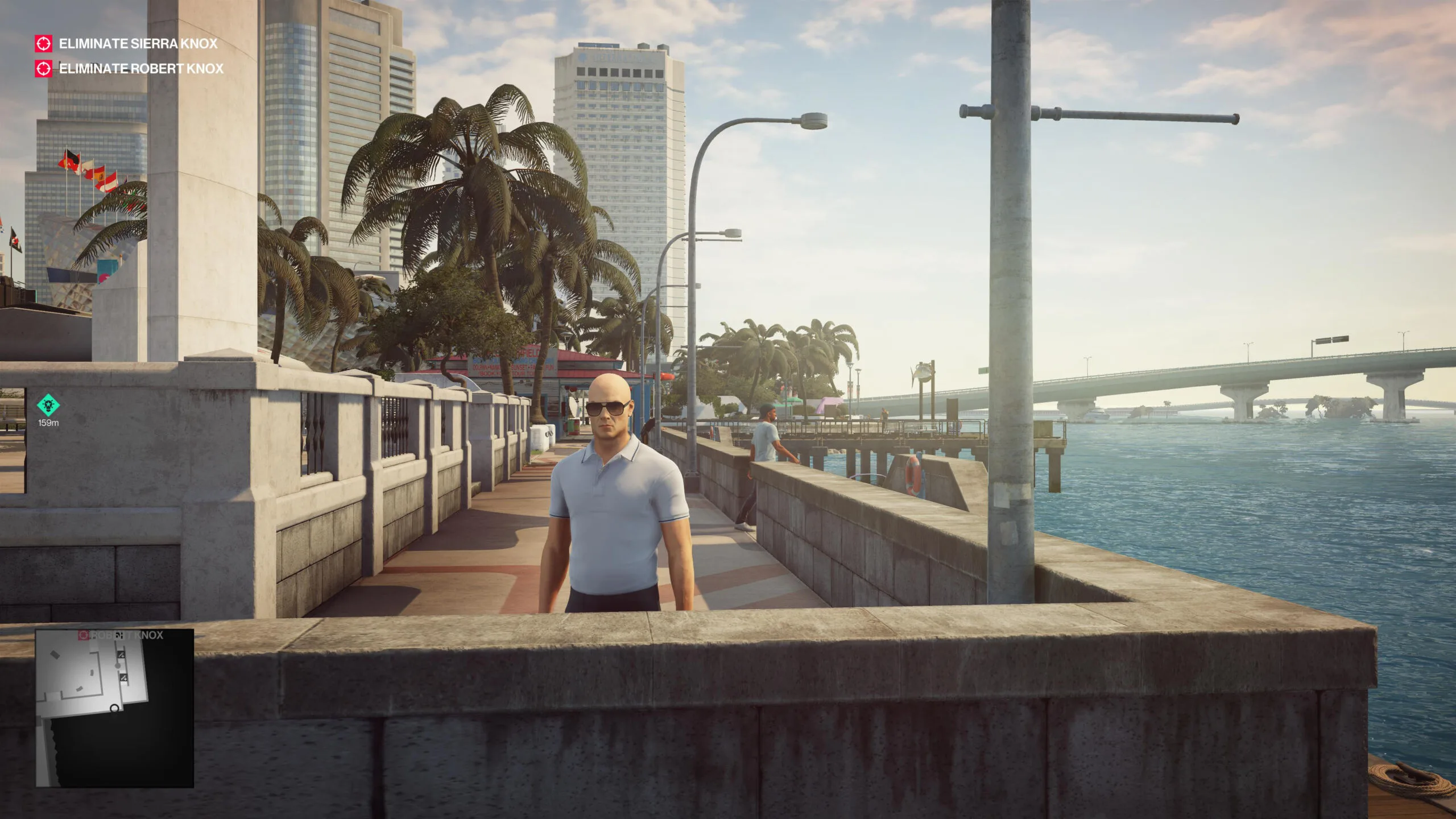 Our testing platform is a recent install of Windows 10 64-bit Home Edition, and we are using an i7-8700K which turbos all 6 cores to 4.7GHz, an EVGA Z370 FTW motherboard, and 16GB of HyperX DDR4 3333MHz. The games, settings, and hardware are identical except for the cards being compared.
Our testing platform is a recent install of Windows 10 64-bit Home Edition, and we are using an i7-8700K which turbos all 6 cores to 4.7GHz, an EVGA Z370 FTW motherboard, and 16GB of HyperX DDR4 3333MHz. The games, settings, and hardware are identical except for the cards being compared.
First, let’s take a closer look at the new PowerColor Red Devil RX 590.
A Closer Look at the PowerColor Red Devil RX 590
The Red Devil RX 590 advertises itself as a card ready for Premium VR and gaming. Also, Vulkan and DX12 support, Chill, ReLive Capture and FreeSync 2 are advertised on the front of the box.
The back of the box gives the power and system requirements which include the need for a minimum 600W power supply unit (PSU). AMD’s technology features are highlighted, and the box also emphasizes PowerColor’s dual-blade fan technology, each with two ball bearings for greater longevity, and MuteFan technology which goes completely silent when the GPU temperatures drop for quiet gaming. Overclocking is featured with a dual-BIOS – one for maximum overclocks, and the other for a quieter and more power-efficient operation.
Opening the box, we see a quick installation guide and an invitation to join PowerColor’s Devil’s Club. In addition, a code for a 3-game bundle is included, worth up to $180 – Resident Evil 2, Devil May Cry 5, and The Division 2.
The Red Devil RX 590 is a large dual-fan card in a 2.5 slot design which is quite handsome in PowerColor’s signature black and red.
The PowerColor Red Devil RX 590’s sturdy backplate features a pentagram inside a stylized circle of ventilation holes, possibly to contain its performance red devil inside. A set of 6-pin plus 8-pin PCIe connectors provide additional power to the card.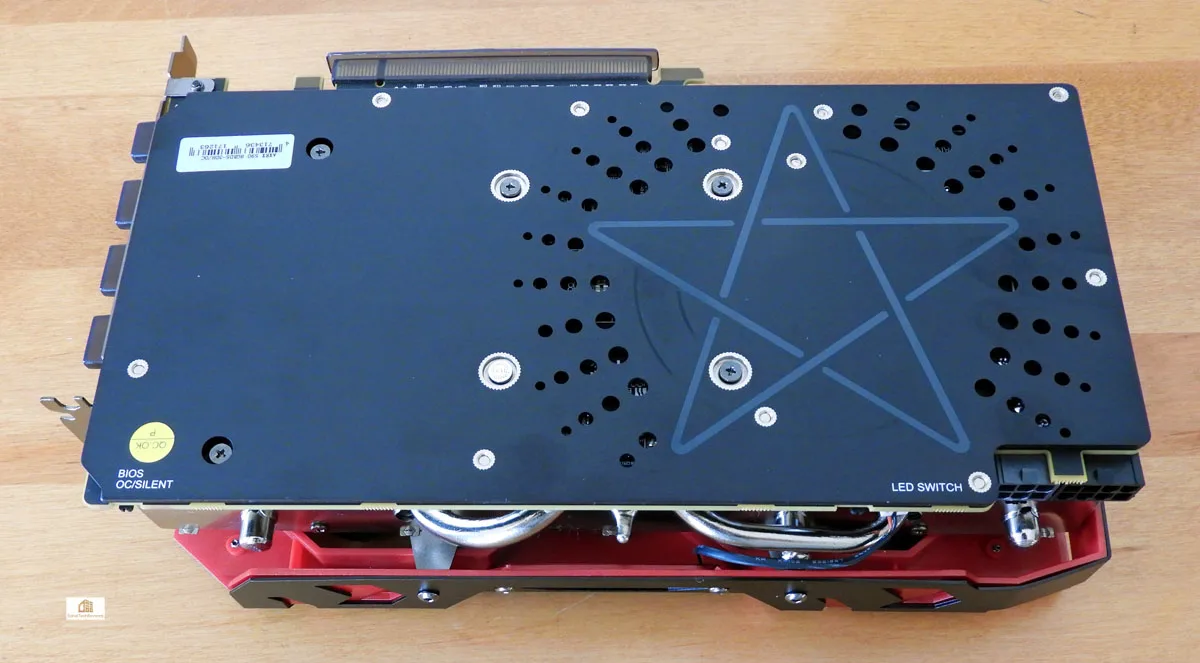 Here is a look at the Red Devil RX 590 from an edge showing its massive heatsink which extends the full length of the card.
Here is a look at the Red Devil RX 590 from an edge showing its massive heatsink which extends the full length of the card.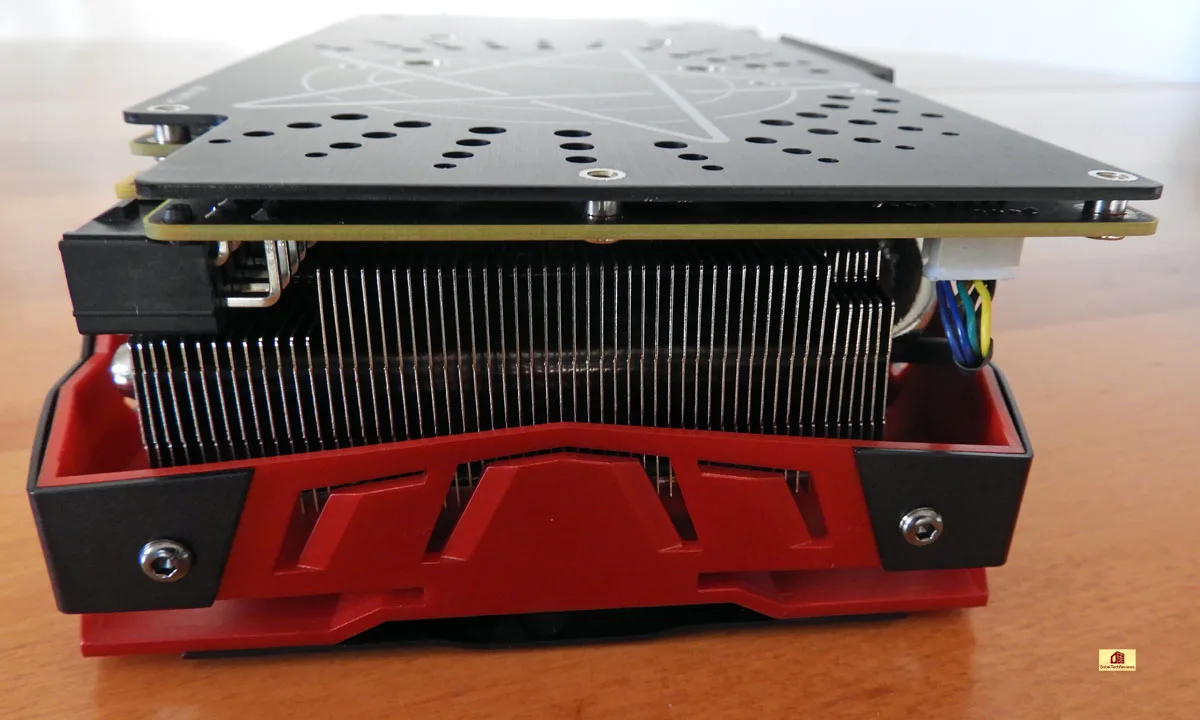
The Red Devil’s RX 590 connectors include 3 DisplayPorts, 1 HDMI connection, and a Dual-Link DVI connector.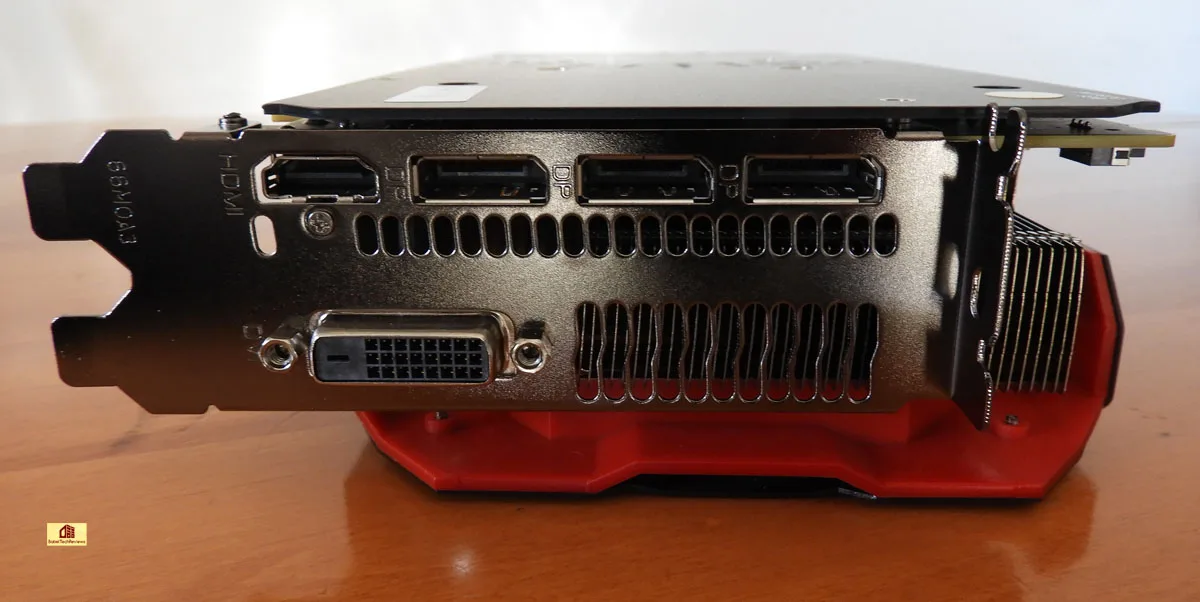
Here is another view with the Red Devil RX 590 installed in our PC. It would also look very good in a vertical installation. The specifications and the PowerColor RX 590 look great as the Red Devil logo lights up in red. Let’s check out its performance after we look over our test configuration and more on the next page.
The specifications and the PowerColor RX 590 look great as the Red Devil logo lights up in red. Let’s check out its performance after we look over our test configuration and more on the next page.
Test Configuration – Hardware
- Intel Core i7-8700K (HyperThreading and Turbo boost are on to 4.7GHz for all cores; Coffee Lake DX11 CPU graphics).
- EVGA Z370 FTW motherboard (Intel Z370 chipset, latest BIOS, PCIe 3.0/3.1 specification, CrossFire/SLI 8x+8x), supplied by EVGA
- HyperX 16GB DDR4 (2x8GB, dual channel at 3333 MHz), supplied by HyperX
- PowerColor Red Devil RX 590 8GB, at stock Red Devil clocks, supplied by PowerColor
- Gigabyte RX 480 G1 8GB, overclocked to RX 580 stock speeds.
- EVGA GTX 1060 SC 6GB, factory overclocked SC clocks, supplied by EVGA.
- PowerColor Red Devil RX Vega 56 8GB, at Red Devil clocks, supplied by PowerColor
- 480 GB Team Group SSD
- 1.92 TB San Disk enterprise class SSD
- 2 TB Micron 1100 SSD
- Seasonic 850W Gold Focus power supply unit
- EVGA CLC 280mm CPU water cooler, supplied by EVGA
- Onboard Realtek Audio
- Genius SP-D150 speakers, supplied by Genius
- EVGA DG-77, mid-tower case supplied by EVGA
- Monoprice Crystal Pro 4K
Test Configuration – Software
- GeForce 416.94 WHQL drivers are used for the EVGA GTX 1060 SC.
- AMD’s Adrenalin Software 18.8.40 (Press Launch Drivers) are used for the RX 580. 18.10.2 is used for the RX 480 at 580 clocks, and 18.10.1 used for the RX Vega 56.
- VSync is forced off.
- AA enabled as noted in games; all in-game settings are specified
- Gaming results show average frame rates in bold including minimum frame rates shown on the chart next to the averages in a smaller italics font.
- Highest quality sound (stereo) used in all games.
- Windows 10 64-bit Home edition latest version 1809. All DX11 titles were run under DX11 render paths. DX12 titles are generally run under the DX12 render path unless performance is lower than with DX11. Three games use the Vulkan API.
- Latest DirectX
- All 37 games are patched to their latest versions at time of publication.
- Wattman used for settings and for overclocking of the Radeons
- MSI Afterburner, latest beta.
- OCAT, latest version
- Fraps, latest version
37 PC Game benchmark suite & 4 synthetic tests
Synthetic
- Firestrike – Basic & Extreme
- Time Spy DX12
DX11 Games
- Grand Theft Auto V
- The Witcher 3
- Fallout 4
- Watch Dogs 2
- Just Cause 3
- Rainbow Six Siege
- Battlefield 1
- Resident Evil 7
- For Honor
- Ghost Recon Wildlands
- Mass Effect: Andromeda
- Prey
- DiRT 4
- Project CARS 2
- Middle Earth: Shadow of War
- Destiny 2
- Star Wars: Battlefront II
- Final Fantasy XV
- Far Cry 5
- The Crew 2
- Assassin’s Creed: Odyssey
- Call of Duty: Black Ops 4
- Hitman 2
- Battlefield V
DX12 Games
- Tom Clancy’s The Division
- Ashes of the Singularity: Escalation
- Hitman
- Rise of the Tomb Raider
- Deus Ex Mankind Divided
- Gears of War 4
- Civilization VI
- Sniper Elite 4
- Total War: Warhammer II
- Forza 7
- Shadow of the Tomb Raider
Vulkan Games
- DOOM
- Wolfenstein: The New Colossus
- Strange Brigade
AMD Control Center Radeon Settings
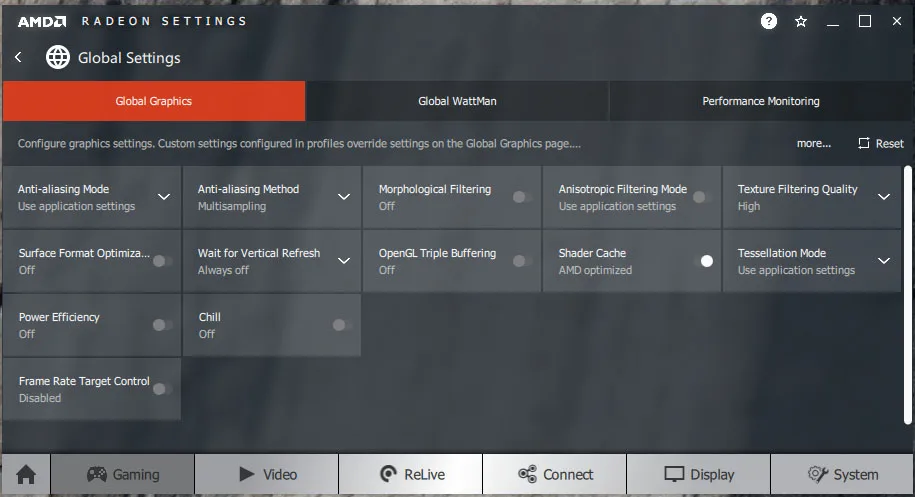 All AMD settings are set so as to be apples-to-apples when compared to NVIDIA’s control panel settings – all optimizations are off, Vsync is forced off, Texture filtering is set to High, and Tessellation uses application settings.
All AMD settings are set so as to be apples-to-apples when compared to NVIDIA’s control panel settings – all optimizations are off, Vsync is forced off, Texture filtering is set to High, and Tessellation uses application settings.
We used Wattman to overclock the RX 480 to stock RX 580 speeds (1340 MHz), and power, temperature and fan limits are set to their maximums to prevent throttling for all Radeons.
NVIDIA Control Panel settings
Here are the NVIDIA Control Panel settings.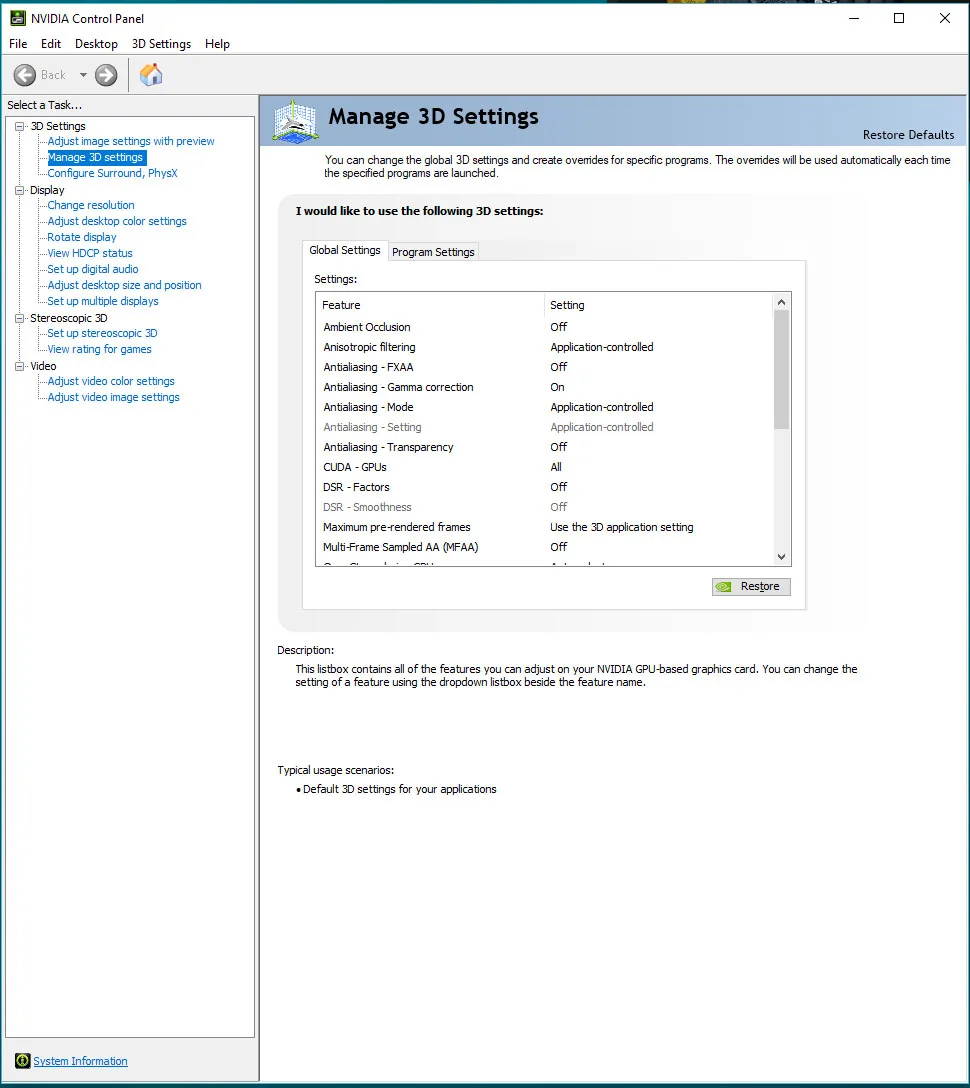
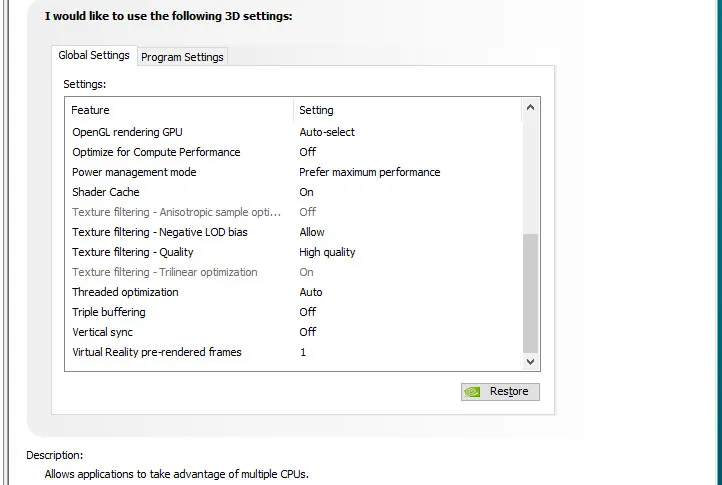 We used MSI’s Afterburner to set our GTX 1060’s highest Power and Temperature targets. By setting the Power Limits and Temperature limits to maximum for each card, they do not throttle, but they can each reach and maintain their individual maximum clocks stock or overclocked.
We used MSI’s Afterburner to set our GTX 1060’s highest Power and Temperature targets. By setting the Power Limits and Temperature limits to maximum for each card, they do not throttle, but they can each reach and maintain their individual maximum clocks stock or overclocked.
Let’s check out Red Devil RX 590 overclocking, temperatures and noise next.
Overclocking, temperatures and noise
We didn’t spend a lot of time overclocking the Red Devil RX 590 for this review. We used the Performance BIOS for this performance evaluation, but we will follow up in our next review by overclocking as far as we can go in an overclocking showdown with the GTX 1060 tomorrow morning.
Here are the PowerColor Red Devil RX 590 default settings.
The clocks are locked to 1576MHz but can peak up to 1625MHz when the frequency setting is set to “dynamic”. The Red Devil’s temperatures stay low in the mid-60s C with the fan running under 1100 rpm. The card will go completely silent in gaming which is welcome for those who prefer a very quiet system by using the Silent BIOS.
For those who want to see the performance settings and overclocking results, check back tomorrow for our Red Devil RX 590 overclocking showdown versus the GTX 1060 SC. As a tease for our follow-up review, we achieved a 2.5% overclock on the core and the Red Devil’s memory clocks reached 2175MHz with complete stability!
Let’s head to the performance charts to see how the PowerColor RX 590 at reference Red Devil RX 590 speeds compares with the RX 480 overclocked to stock RX 580 clocks and versus its main competitor, the EVGA GTX 1060 6GB SC – a rather highly factory overclocked card. The SC which stands for “superclocked” is factory-clocked 102MHz over the reference GTX 1060 speeds and it can reach and maintain close to 2000MHz on its core at peak Boost.
Performance summary charts
Here are the performance results of 37 games and 2 synthetic tests comparing the Red Devil RX 590 8GB with the Gigabyte RX 480 at RX 580 speeds (1340MHz) and versus the factory overclocked EVGA GTX 1060 6GB SC. In addition, we have added the PowerColor Red Devil RX Vega 56 for comparison although it is a factory overclocked card that is in a higher class and in a much higher price range.
The highest settings are always chosen and the settings are listed on the charts. The benches were run at 1920×1080 and at 2560×1440. Open each chart in a separate window or tab for best viewing.
Most gaming results show average framerates in bold text, and higher is better. Minimum framerates are next to the averages in italics and in a slightly smaller font. A few games benched with OCAT show average framerates but the minimums are expressed by frametimes in ms where lower numbers are better.
The first column shows the RX 580’s performance. Column two represents the Red Devil RX 590, and Column three represents the GTX 1060 SC performance. Wins between the RX 590 and the GTX 1060 are shown by yellow text, and both sets of numbers are in yellow if they are equal. The last column represents the Red Devil RX Vega’s performance, and an “X” means the benchmark was not run.
We see the Red Devil RX 590 destroys the RX 480 clocked to RX 580 reference speeds. The RX 590 would be faster than any factory overclocked RX 580 including the Sapphire Nitro Pulse. This time, however, the Red Devil RX 590 is significantly faster than the EVGA GTX 1060 6GB SC overall, winning most of our 37 game benchmarks. We also note an advantage with the 8GB vRAM that the RX 590 uses in Wolfenstein: The New Order over the 6GB of the GTX 1060 at 2560×1440 using the highest settings.
The GTX 1060 SC gained some performance from its latest GeForce 416.94 driver which released on Monday evening, but it is no match for the Red Devil RX 590 except in a few games where NVIDIA already has a large advantage over the stock RX 580.
It will be interesting to see if anything changes when we manually overclock our Red Devil RX 590 to its maximum and pit it against the manually overclocked EVGA GTX 1060 SC 6GB in our overclocking showdown due tomorrow morning.
Let’s head for our conclusion.
The Conclusion
The Red Devil RX 590 improves significantly over a stock RX 580 and easily takes the mid-range performance crown away from any GTX 1060 at factory overclocks winning a large majority of the 37 games we tested.
The Red Devil RX 590 is very good deal at $279.99 which includes a $180 bundle of 3 very good games. The EVGA GTX 1060 SC sells for $259, and currently it has a $20 mail-in-rebate available and comes bundled with Monster World from Newegg. The Sapphire Nitro Pulse is one of the very fastest RX 580s and it costs $279 shipped from Newegg. We would definitely pick the Red Devil RX 590 from among these three cards if we are looking for both high performance and good value.
Let’s sum it up:
PowerColor Red Devil RX 590 Pros
- The PowerColor Red Devil RX 590 is much faster than any RX 580 by virtue of its being fabricated on the 12nm process, and it will beat any premium factory overclocked RX 580.
- At $279 the Red Devil RX 590 is the same price as the most premium RX 580s. In addition, it comes with 3 great games bundled with it for an additional value of $180.
- The Red Devil RX 590 wins most of its benches against the single game-bundled slightly cheaper EVGA GTX 1060 SC.
- The Red Devil RX 590 has a very good power delivery and 2-fan custom cooling design that is very quiet.
- Dual-BIOS give the user a choice of quiet and less overclocking, or a bit louder with higher power-unlimited overclocks.
- FreeSync2 eliminates tearing and stuttering and it is much less expensive than comparable GSYNC displays.
- The RX 590 has 8GB of vRAM compared with the 6GB of vRAM used in the price-competitive GTX 1060.
PowerColor Red Devil RX 590 Cons
- None.
We will not comment on the Red Devil’s ultimate overclock until tomorrow’s showdown with the EVGA GTX 1060 SC 6GB. The Red Devil RX 590 is a very good deal for those who game at 1920×1080 or 2560×1440, and it is an excellent alternative to the GTX 1060 6GB, especially for those who prefer AMD cards and FreeSync2 enabled displays which are significantly less expensive than GSYNC displays.
The Verdict:
- PowerColor’s Red Devil RX 590 is solidly built handsome card, and it has higher clocks out of the box than any factory overclocked RX 580. It beats the GTX 1060 factory overclocked cards by a decent margin. It represents a solid value at $279 with a great 3-game bundle, and it deserves BTR’s Great Value Award.
We do not know what the future will bring, but if you are buying right now, the PowerColor Red Devil RX 590 is a kick ass card that is best in class. The Red Devil RX 590 offers an excellent performance improvement over the RX 580, and it also beats the competing GTX 1060 6GB SC that is now priced in a lower but similar price range. We have also noted that the overall pricing of the GTX 1060 has just now softened as a response to the RX 590.
Stay tuned, there is a lot coming from BTR. Tomorrow we will continue with our Red Devil RX 590 series versus the EVGA GTX 1060 SC 6GB in an overclocking showdown. And we will also post our review of Battlefield V’s implementation of RTX ray tracing this weekend.
Happy Gaming!


